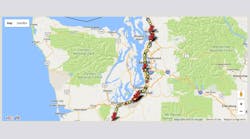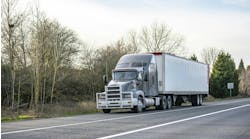For trucking along the Pacific Coast, I-5 is one of the main routes as the only continuous U.S. interstate that runs from Mexico to Canada. It's also the primary north-south highway through Washington, and that state's busiest roadway overall. A new interactive map shows the most dangerous parts of I-5 for semi-truck collisions in the Evergreen State.
As the saying goes, "keep your friends close..." Personal injury law firm Davis Law Group of Seattle, whose founder Chris Davis has written a book on filing commercial truck accident claims, tracked accident data over a 15-month period from Jan. 1, 2017 to March 30, 2018 and is updating the map going forward.
The goal is to illustrate "how dangerous large trucks are on the Interstate 5 corridor through Washington state," the law firm says. But from another angle, it's also an evolving resource for commercial truck drivers using the route to be extra vigilant of "hot zones" where collisions are most likely. Davis Law Group rated the areas based on fatality, serious injury, and minor injury accidents that have occurred involving trucks.
According to the map, the current most dangerous areas of I-5 are:
1. King County, I-5 mile posts 140-177. Given that 60% of Washington's population is concentrated in the Seattle metro region, it's not surprising that King County enveloping that city would be the most dangerous to travel.
"King County and its cities along I-5 — Federal Way, Kent, SeaTac, Tukwila, Seattle and Shoreline — saw 66 commercial vehicle accidents during the studied time period, by far the most of any area," according to Davis Law Group. "Heavily traveled routes in the area merging with other major routes such as I-90 and I-405 make for a treacherous passing through this metropolitan hub."
The law firm charted one fatal and five serious accidents in this county out of the total. Notably, the fatality was actually a truck driver in a single-vehicle crash in Seattle; there were a high number of lesser collisions that caused minor injuries, which can still be very costly for fleets and trucking companies.
2. Pierce County, I-5 mile posts 115-139. The county to the south of Seattle, with truck routes running through Tacoma and often farther south to and from Portland, OR, is shown as the second most dangerous area of I-5.
There were 42 truck crashes in total there during Davis Law's study period. There were actually more fatalities in Pierce than King County — a total of three fatal accidents occurred, the firm found, with all of those in Lakewood, WA. There were also two serious collisions there, meaning Lakewood may be the most treacherous single location of I-5 for trucks.
3. Snohomish County, I-5 mile posts 178-217. You guessed it: the county to the north of Seattle follows as the next-most frequent for truck crashes. Davis Law noted that this county can see high traffic flows from the Boeing Co.'s airplane assembly plant and Everett Naval Station — both in Everett — so that city's particular stretch of I-5 may be at higher risk in this county.
There were three fatal and three serious accidents in Snohomish County over the 15-month study period, according to Davis Law.
4. Lewis County, I-5 mile posts 55-87. Just south of Olympia, the state's capital, is this county midway between Seattle and Portland, OR.
There were 15 collisions in Lewis County involving heavy trucks during the study period, the law firm determined, with four causing serious injuries and one causing a fatality. Though not a large city, Centralia is the most populous area trucks will pass through here on I-5, followed by Chehalis, the county seat, to its south.
5. Thurston County, I-5 mile posts 88-114. Thurston County houses Washington's capital, Olympia, as well as Lacey, which is almost as populous, and Tumwater on I-5. This county is right between Pierce and Lewis counties on the interstate.
Davis Law mapped 17 collisions involving trucks here, including two fatalities. The firm claimed both of those were the fault of a truck driver, distracted in one case and under the influence of drugs in the other.
Takeaways
Thus, overall, the riskiest parts of I-5 for truck crashes as rated by Davis Law generally track some of Washington's more populous areas along the interstate from mile posts 55 to 217. But traffic volume isn't the only thing to blame, since they didn't include larger cities like Vancouver and Longview on I-5 closer to Oregon.
And again, other than the "fender bender" accidents more common — and probably to be expected — in more densely populated Seattle, the city of Lakewood, WA was a standout for frequency and severity of crashes involving heavy trucks.
If the numbers hold up, it could indicate that Lakewood's largest I-5 junction, where State Route 512 comes in from the east, is one that truck drivers should be particularly aware of. Here's the Washington Dept. of Transportation's traffic cam for that interchange and travel alerts link for the entire section of I-5 that the law firm deemed most dangerous.



